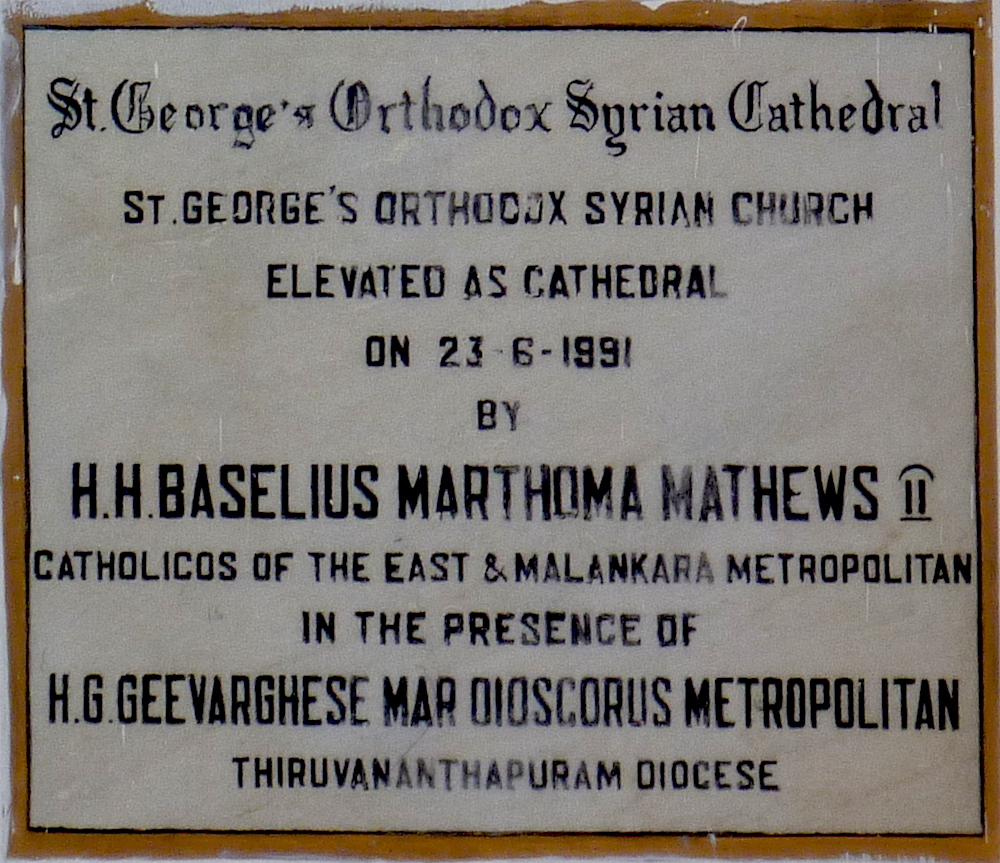

St George's Syrian Cathedral, Trivandrum (Thiruvananthapuram), at Spencer Junction on Mahatma Gandhi Rd. According to the cathedral's own website, "Our church was founded in 1890 by two brothers looking for a place to practice their faith. It took two years to erect the first building for the church, however, that is still the base for the building we currently are in." The church is bigger than it looks at first sight, with a tower at the east end.

As the photograph above right indicates, St George's is very central, and speaks of the importance in the community of the Syrian Christians. This group of South Indian Christians is, indeed, of great interest: "at the present day one-fifth of the people of Travancore are Christians. The greater part of these Christians are known as Syrian Christians," wrote Gordon T. MacKenzie, the British Resident not long after St George's was built:
They are Hindus by race and speak the Malay alam language that is spoken by their neighbours who are Hindus by religion. This name, Syrian Christians, has been given because in their churches they still use Syriac or Chaldaic liturgies. These Syrian Christians are found in central and north Travancore, in the Cochin State and in the Malabar district of British India. There are none in south Travancore. The bulk of them are Roman Catholics but nevertheless follow their own Syriac Rite (1). Others adhere to the Jacobite Patriarch of Antioch (2). The remainder approach the Protestant standards of doctrine and ritual and are usually called the Reformed Syrians, although they themselves dislike that name and call themselves the Christians of St. Thomas (3). These three bodies of Syrian Christians agree on one point, in claiming to be the descendants of the converts made by the Apostle St. Thomas on this coast or of early Christian immigrants from Persia or Mesopotamia. [1]


Left: "Syrian Christian Matron." Source: MacKenzie, following p. 24. Right: "Syrian Christian Wedding." Source: MacKenzie, following p. 32.
Many of the coastal Christians had come to central Trivandrum as recently as the early nineteenth century, when the Raja of that time called on the fishermen to help him during an attempt to topple the government (including the British Resident and the Prime Minister):
They assembled at Trivandrum in immense numbers, each man armed with a short bludgeon. The bowmen from the hills appeared at the same time in the Rajah’s behalf, and the Nayars [the rebel warriors] laid down their arms and fled. About fifty of the ringleaders were seized and hanged. The battalions were broken and the Rajah accepted of a subsidiary force from the English. [qtd. in MacKenzie 64]
Along with missionary activity, this growing Christian presence helps to explain the founding and building of new churches in the Victorian period. Although a hoped-for merger of the two groups of Christians never took place, some Syrian Christians did in fact become members of the Church of England (see Mackenzie 39). Appropriately enough,
despite its gothic pinnacles, there is still something of a seaside church about this small whitewashed cathedral in the very heart of Thiruvananthapuram.

Plaque on the outer wall of the church.
Photographs and text by Jacqueline Banerjee. You may use these images too without prior permission for any scholarly or educational purpose as long as you (1) credit the photographer and (2) link your document to this URL in a web document or cite the Victorian Web in a print one. [Click on the images to enlarge them.]
Bibliography
MacKenzie, Gordon T. Christianity in Travancore. Trivandrum: Trivandrum Government Press, 1901. Internet Archive. Contributed by Harvard College. Web. 30 April 2019.
"Our History" (the cathedral's own website). Web. 30 April 2019.
Travancore State Manual. Trivandrum: Travancore Government, 1906. Internet Archive. Contributed by Harvard College Library. Web. 30 April 2019.
Last modified 7 May 2019